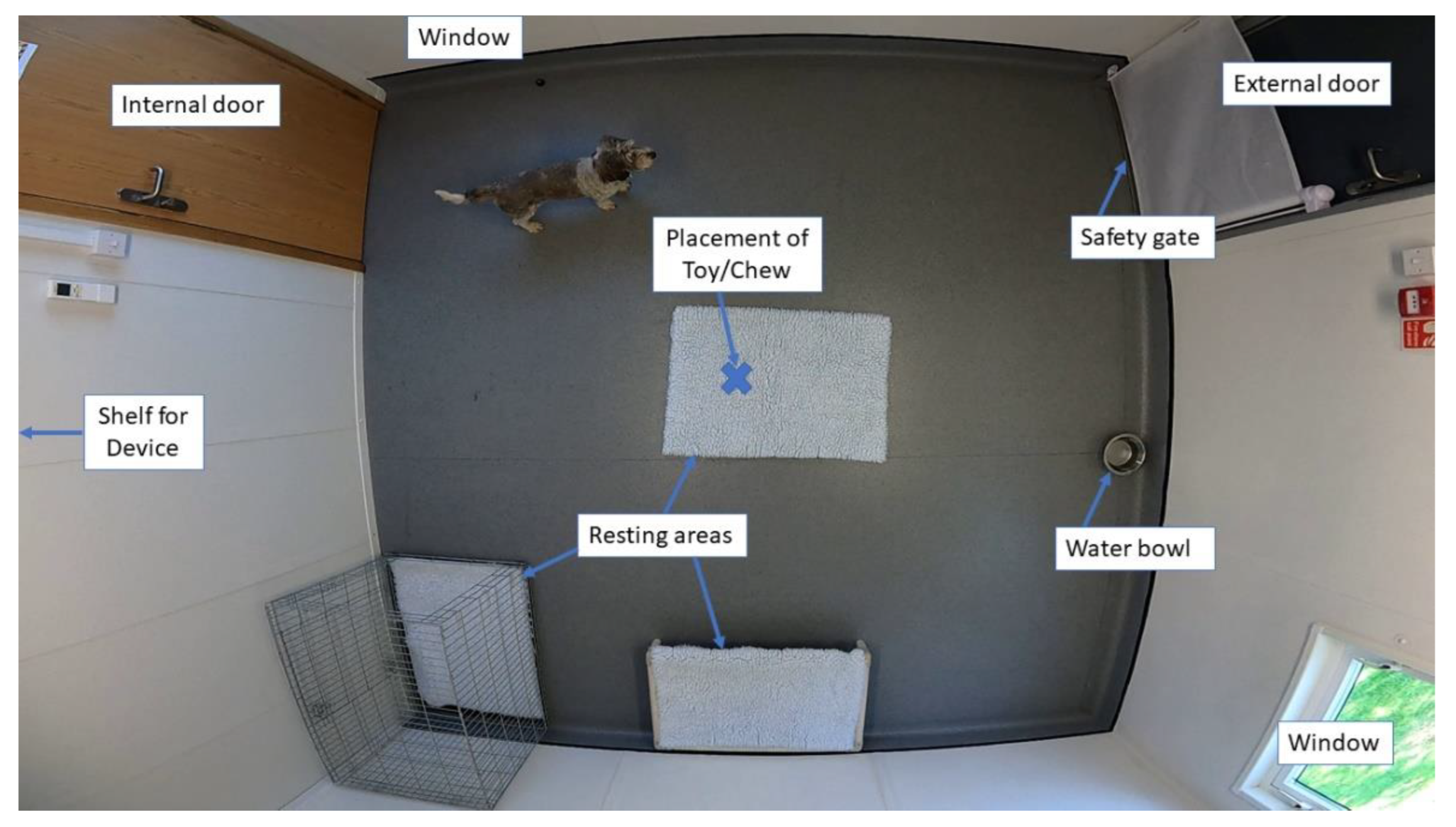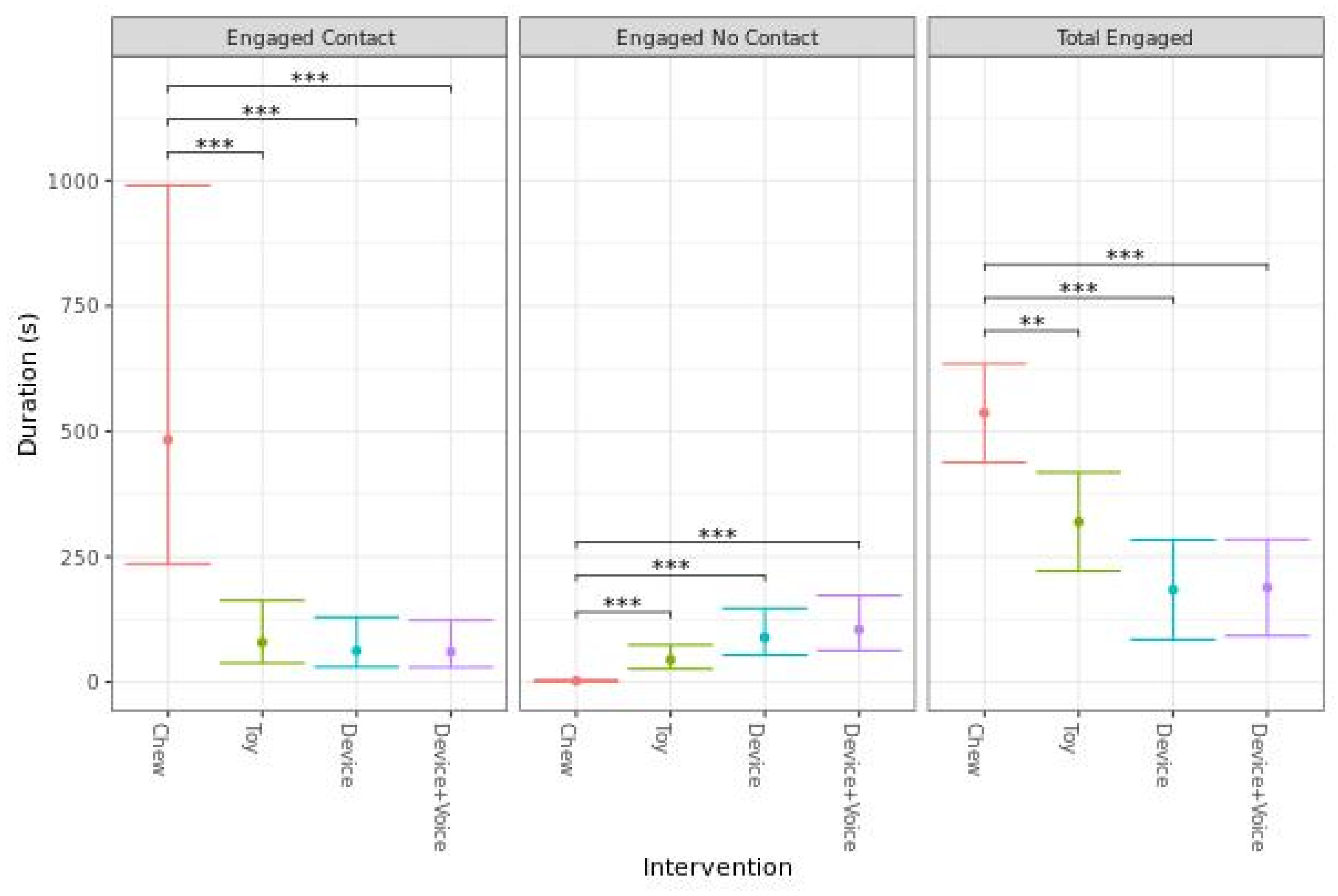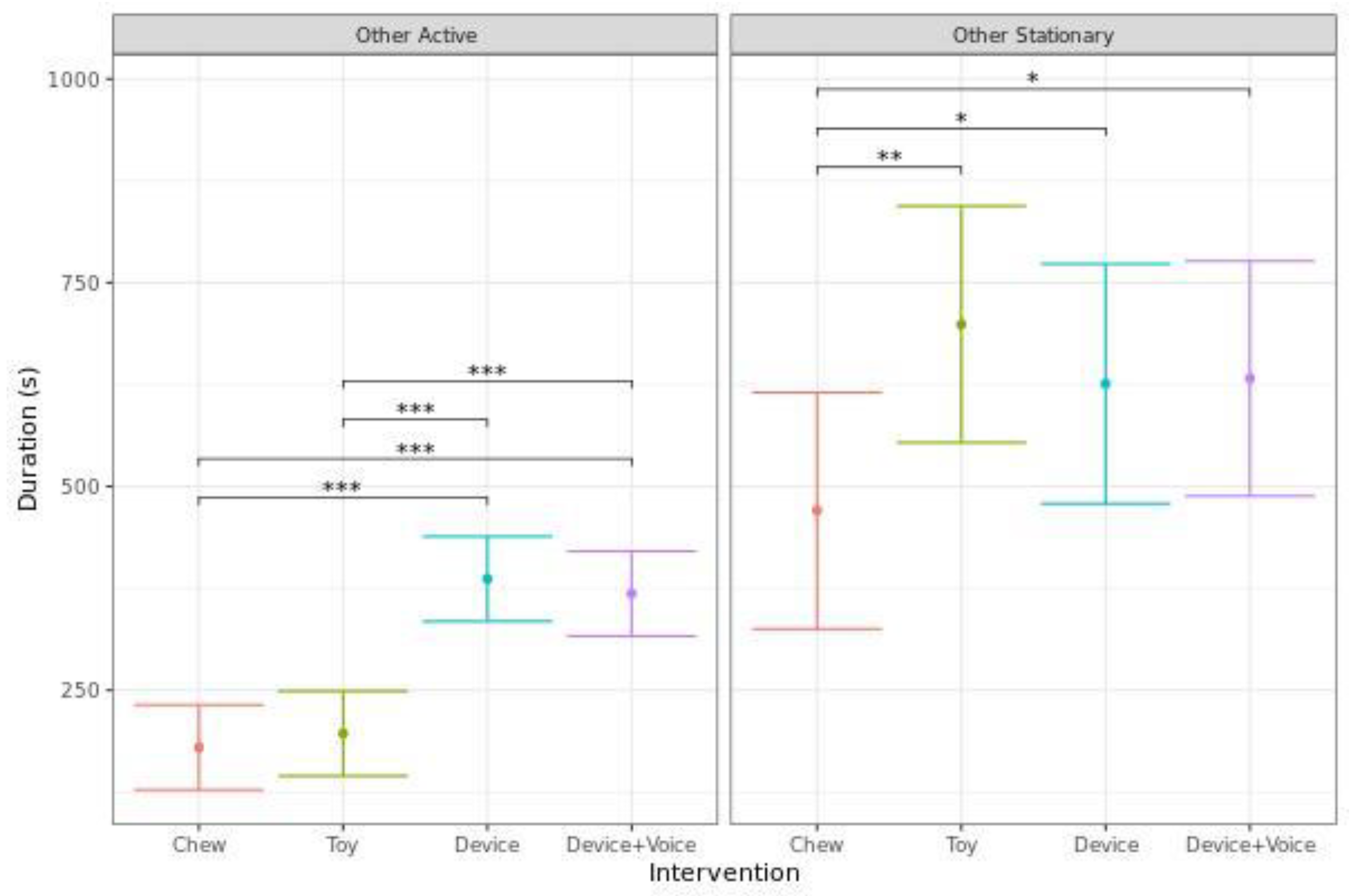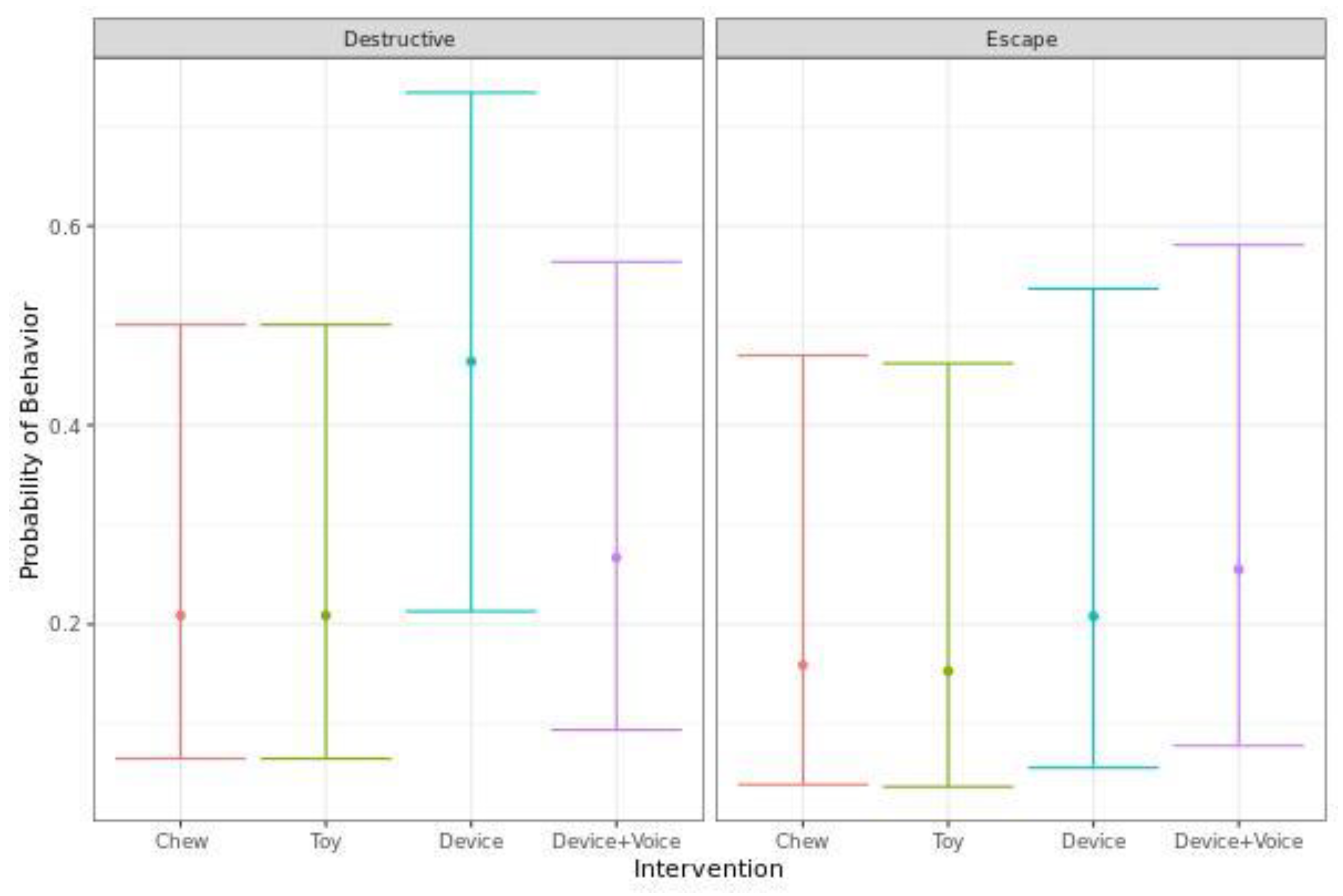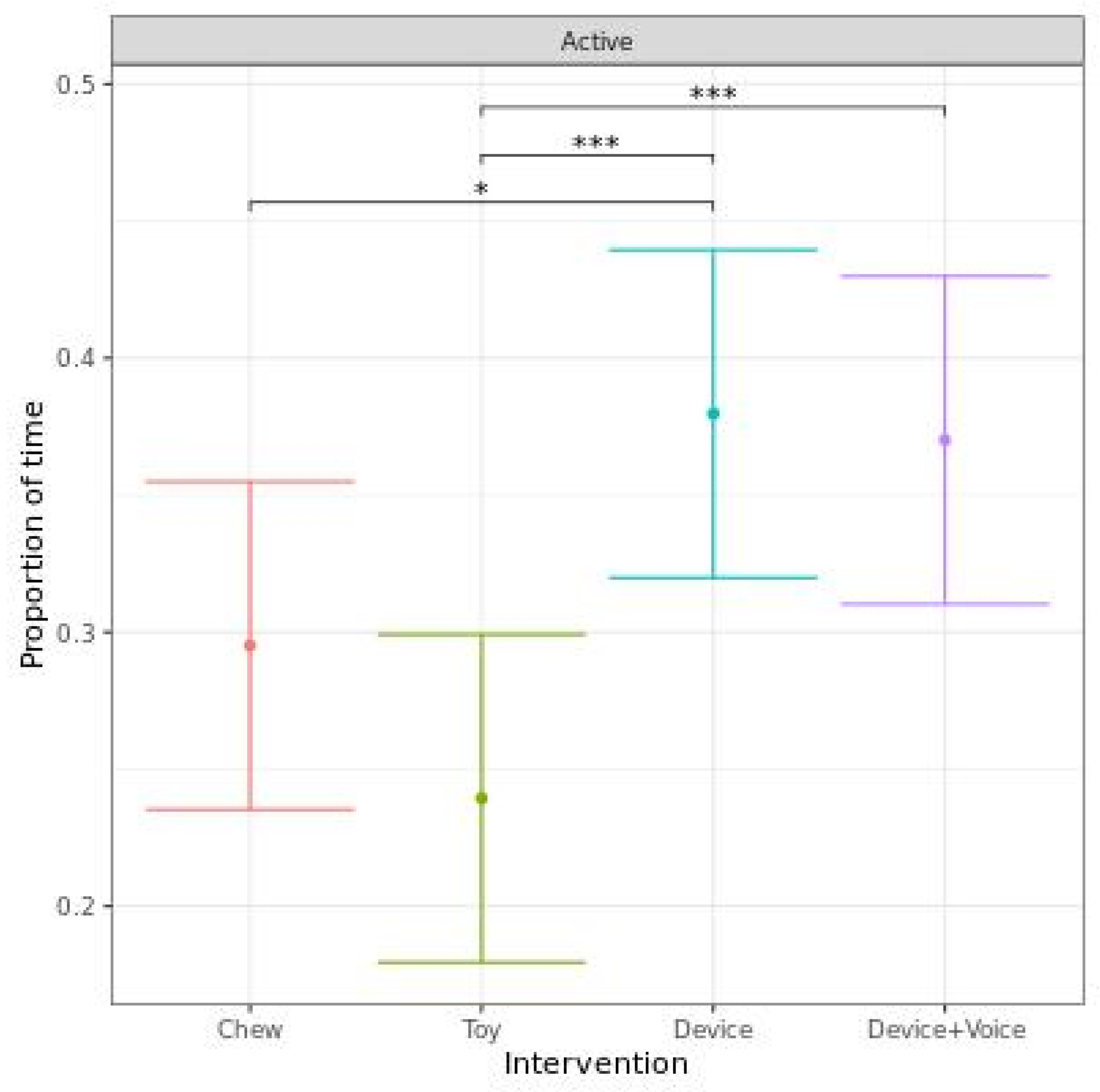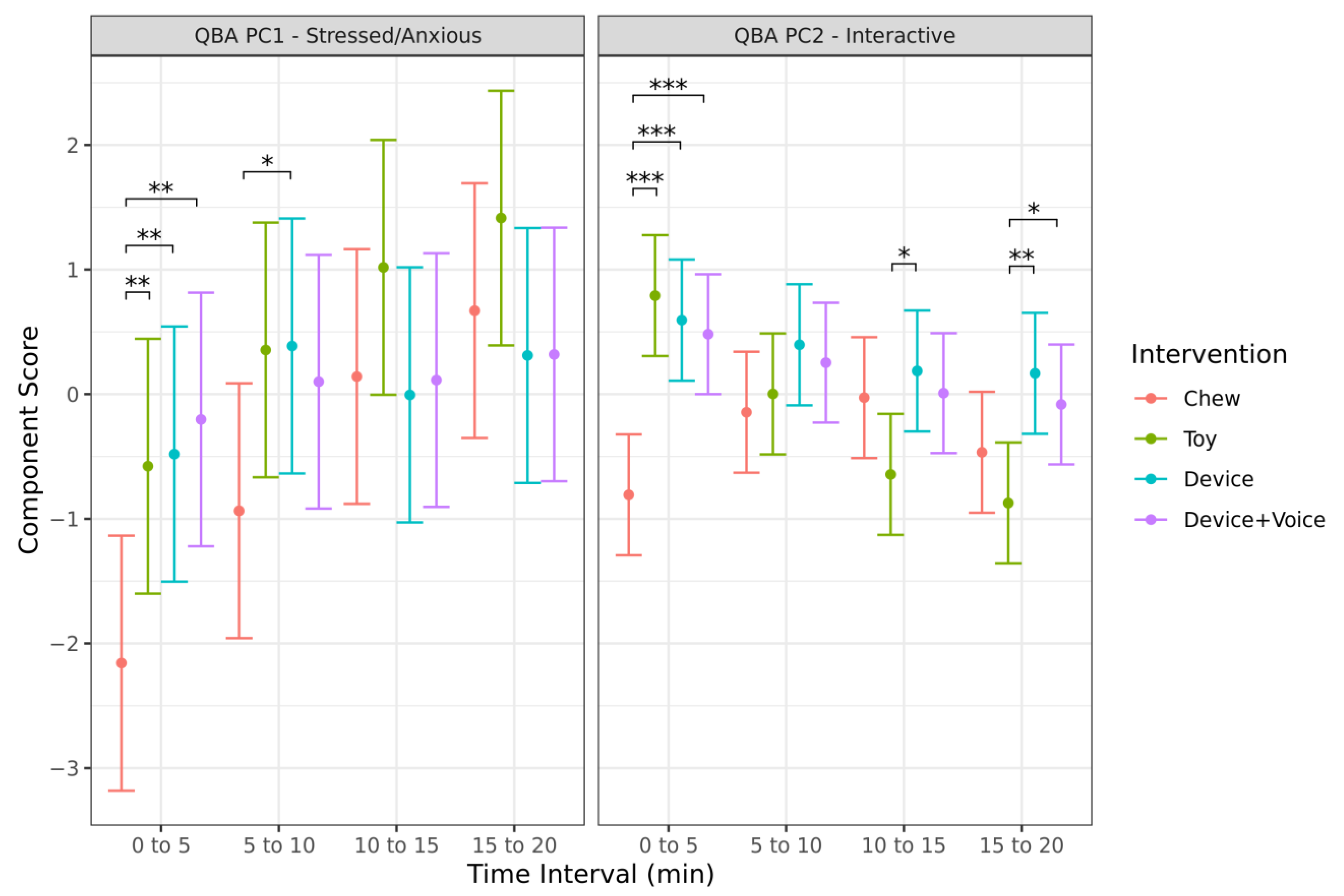1. Introduction
One of the major welfare concerns affecting pet dogs in modern society is negative emotional states caused by extended periods of separation from attachment figures such as owners or other pets. Dogs are a social species that can develop meaningful connections with their caregivers, similar to those between children and their parents [
1]. When isolated for extended periods, such as when their owners are at work, dogs are likely at risk of negative emotional states, including boredom, frustration, fear and anxiety [
2]. Separation-related problems, which can be defined as any “behavior that is a problem for an owner when their dog is left alone, regardless of cause” [
2], are estimated to be shown by 22–55% of dogs [
2]. It is possible a much larger proportion of dogs suffer from issues that are related to separation but are not visible to the owner. This may occur due to a lack of behavioral expression from dogs [
3], owners not accurately recognizing signs of separation-related issues, or simply because the owner is not present when the behaviors are exhibited. This behavioral concern is particularly relevant due to recent events following the lockdowns of the COVID-19 pandemic. Many dogs spent more time in close contact with their caregivers, and owners have reported being concerned that their pets will develop separation anxiety as people start returning to their normal routines [
4]. Overall levels of separation anxiety in the United Kingdom do not appear to have changed between the start of the lockdown period and October 2020 [
5]. However, a subset of dogs who had not previously shown signs of separation anxiety before the pandemic started exhibiting separation-related behavioral problems by October 2020, with those who had the greatest reduction in time left alone being the most at risk [
5]. Additionally, many workplaces had not fully returned to normal working by October 2020, so it is possible additional increases in separation-related problems will be seen in coming months and years.
For severe cases of separation anxiety, strict desensitization and counter-conditioning protocols, aimed at altering the dog’s emotional reaction to the owner’s departure, have been demonstrated to be effective in improving behavior [
6]. In addition, numerous studies have examined the efficacy of different anti-anxiety medications such as clomipramine [
7,
8] and fluoxetine [
9,
10], or more “natural” remedies such as dog-appeasing pheromone [
7], which can be used in combination with the behavior modification protocols to assist in increasing the latter’s efficacy. Numerous studies have been conducted assessing the efficacy of these treatment plans with varying degrees of success [
11]. However, these protocols require significant investment of time, dedication and skill level from the owner, as well as financial costs of consulting a behavior professional [
12]. Additionally, these interventions may not be as effective for separation-related behaviors motivated by emotional states other than anxiety, such as frustration or boredom when left on their own [
2].
An alternative method for alleviating negative emotional states and improving animal welfare is through environmental enrichment. Enrichments can take many forms, including changes to the physical structure of the environment, providing different sensory stimulation, or through different feeding methods [
13]. Generally, the aim of enrichment is to add complexity to the animal’s environment, which can result in improved welfare by providing the animal with choices of different behaviors they can perform, leading to increased behavioral diversity. Successful enrichment can result in a reduction in abnormal behaviors while increasing positive interactions with the environment, promoting a positive emotional state. Enrichments can also make more permanent changes to the animals’ wellbeing through improved ability to cope with challenges and improved cognitive performance [
13,
14]. While the use of various types of enrichments to improve animal welfare has been extensively studied in captive animals in zoo [
15,
16] and farm settings [
17,
18], less research has studied enrichments for companion animals. Research on dogs to date has primarily been limited to populations of kenneled dogs in laboratory or shelter settings [
19]. For example, studies in laboratory-housed dogs have demonstrated that provision of chew toys was successful in decreasing inappropriate chewing and time spent inactive [
20], while the provision of a treat-stuffed toy contributed to more variable behavioral patterns, including decreased inactivity and barking and increased appetitive behaviors [
21]. In shelter dogs, enrichment provided in the form of training sessions and food-filled toys increased sitting, lying, and quiet behavior, as well as decreased jumping [
22], while the provision of classical music resulted in more time sleeping and less time vocalizing [
23]. A study examining assistance dogs identified that enrichments were successful in increasing relaxation behaviors and reducing alert and stress behaviors in the hour after the enrichment was provided [
24]. This effect was greatest with play-based enrichments and lowest in food-based enrichments. However, the play-based enrichments used in that study required social interaction with another dog or handler and, therefore, would not be possible during periods of social isolation. Another study which investigated pet dogs found that the provision of food-based enrichments successfully reduced problematic behaviors when dogs were separated from their owners for a short period of time [
25]. While dogs were not socially isolated during that study as the experimenter remained in the room, this does indicate food-based enrichments may be a promising option for alleviating negative emotional states in dogs during periods of social isolation.
Pet dogs often receive enrichment through interactions with their owners; however, this form of enrichment is no longer present when dogs are left alone. While it is commonly recommended by professionals that dogs be provided with different types of enrichment when being left alone for extended periods, what type of enrichments to use and the efficacy of these interventions have not been scientifically evaluated.
The overall aim of this study was to identify which forms of enrichment, in this case treats and treat-filled devices, dogs chose to interact with when left alone. The secondary objective was to determine what effect these different enrichments had on the dog’s emotional state.
2. Materials and Methods
2.1. Subjects
Twenty adult dogs, twelve females and eight males (two entire females and one entire male), representing a medium breed (10 Petit Basset Griffon Vendéens) and a large breed (10 Labrador Retrievers), with a mean age (±sd) of 4.8 ± 2.5 years ranging from 1.6 to 9.7 years, participated in the study. All dogs were housed in pairs or small groups within kennels at the Waltham Petcare Science Institute (Leicestershire, UK), with housing kept consistent throughout the duration of the study. All dogs were provided with comprehensive training and socialization programs, adjusted to the needs of individual dogs as per the institute’s standard husbandry requirements. All dogs were routinely fed two meals per day with a morning feed at 9:30 a.m. and an afternoon feed between 2:30 and 3:00 p.m.
In the interest of dog and human welfare, dogs were excluded based on previous observations of resource guarding, or excessive destructive behavior with risk of self-injury or ingestion of foreign bodies, as well as any dietary restrictions that would not allow the consumption of the treats or kibble used during testing. Prior to the commencement of testing, all dogs were habituated to the test room while in the presence of a familiar handler. In addition, each dog was exposed to each of the enrichments while in the presence of a familiar handler to ensure acceptance and to minimize the effect of any differences in previous experience. The duration and frequency of these habituations and exposures were not defined. Instead, a minimum of one exposure was required, with additional sessions occurring as needed until the dog displayed confident body language and interacted with the enrichments. An average of 2.25 sessions were required to reach habituation criteria, with all dogs reaching criteria within 3 sessions (15% 1 session; 45% 2 sessions; and 40% 3 sessions).
Once fully comfortable in the testing environment, each dog was exposed to a social isolation event, where they were left alone in the room for 20 min. During this first exposure, no enrichments were present, and no data were collected. This event served to reduce potential novelty effects on the dog’s responses.
2.2. Testing Area
All testing was conducted within a test room (3.71 m × 3.58 m) located within a portable building at the Waltham Petcare Science Institute (
Figure 1). The room had two windows and an internal and external door (only the external door was used to bring dogs into and out of the room). In the interest of dog safety, a retractable mesh safety gate was mounted inside the external door and was used to prevent the dog rushing out when the handler opened the door upon returning. The room was set up in a standardized manner, with multiple resting areas, including vet bedding placed on the floor, in a crate, and on an elevated dog bed. Vet bedding was changed between each dog and the room cleaned with a virucidal cleaner (Selgeine, Selden Research Ltd., Buxton, UK). In addition, dogs were provided with free access to fresh water in the form of a metal water bowl that was filled at the beginning of each test session. A radio played in an adjoining room throughout the test sessions to mask potential background noises that may have distracted the dogs.
2.3. Enrichments
Four food-based enrichments were selected to be tested to represent different types of enrichment recommended for use when leaving dogs home alone. These were a long-lasting chew (Chew), a food-dispensing toy (Toy), and a smart food-dispensing device with (Device + Voice) and without (Device) a person talking to the dog via the device’s app. For the Chew enrichment session, a chew (PEDIGREE
® GOOD CHEW
TM Treat, Mars Petcare UK, Slough, UK) was placed in the center of the test room at the start of the session, with the dogs over 25 kg receiving a large-sized chew and dogs 25 kg and under receiving a medium-sized chew (as per recommended feeding guidelines). Adult dog main meal kibble (JAMES WELLBELOVED
TM Adult Lamb and Rice, Mars Petcare UK, Slough, UK) was used for the Toy and Device; it was selected to be rewarding to the dogs based on novelty and palatability and had a consistent size and shape (~11 mm diameter) that enabled it to be obtained from the Toy and minimized jamming in the Device. The amount offered was 77 g for medium dogs (≤25 kg) and 126 g for large dogs (>25 kg). This amount was selected to match the kcal of the respective chews (medium: 270 kcal, large: 445 kcal). For the Toy enrichment session, a food-dispensing toy (KONG Wobbler
TM, KONG Company EU Ltd., Wiltshire, UK) was filled with the appropriate quantity of kibble and was left in the center of the room, except for two dogs who refused the novel kibble and who were instead given their normal background dry main meal diet. The toy was hollow and made of a hard, durable plastic with a weighted base, and had a small round hole at the side through which kibble could fall out. The dogs were required to move the toy with their paw or nose to cause it to rock and kibble to fall from the hole. For both the Device sessions, a smart food-dispensing device (FURBO
TM, Taipei, Taiwan) was filled with kibble and placed on a high shelf (~1.8 m) within the test room out of reach of the dog. The experimenter used an app on a mobile phone or tablet to trigger the device to dispense kibble once every minute during the social isolation event. Furthermore, for the Device + Voice sessions, a script was read by the experimenter (female) using a friendly, high-pitched voice (as they would typically talk to a dog they were trying to engage) that consisted of a series of positive phrases (
Appendix A—Device Script). One of these phrases was read immediately prior to dispensing each kibble.
2.4. Study Design
Dogs were exposed to each of the four different food-based enrichments separately during a series of 20 min social isolation events in a cross-over design with order randomized using a balanced Latin Square. All testing occurred from April to July 2021, with sessions scheduled in the afternoon prior to their afternoon meal (between 12:30 and 2:30 p.m.). Each dog participated in a maximum of two sessions a week with at least one day in between test sessions. On the days dogs received enrichment, their daily food was reduced by 25% to avoid weight gain, and any food not consumed during the sessions was re-offered at their afternoon meal.
Dogs were closely monitored throughout each test session using CCTV cameras (Dahua 4K IR Turret Network Camera with built-in microphone and varifocal motorized lens: 2.7–12 mm) and were monitored for signs of distress and/or safety concerns based on pre-defined removal criteria. These included excessive barking, hyperventilation, extreme hypersalivation, cowering, repeated vigorous escape attempts, and behaviors resulting in self-harm and/or the ingestion of foreign bodies. While no dogs had to be removed from test sessions during the study, one dog was removed from the study following three test sessions due to a deterioration of behavior across repeated testing (1.8yo entire male Labrador Retriever). This included a general increase in undesired behaviors observed outside of testing, as well as an increase in negative responses observed during the test sessions, including poor recovery upon return of the handler. The data from this dog were removed from analysis.
2.5. Data Collection
During each social isolation event, dogs were video-recorded using the CCTV cameras mounted in each corner of the room. Two camera angles that covered the entirety of the room were used for behavioral coding. The duration and/or frequency of different dog behaviors were coded by two trained coders using The Observer XT (version 15) following a detailed ethogram (
Table 1). Videos were randomly assigned to coders, with 10 videos coded in common to assess inter-rater reliability. Additionally, 5 videos were re-coded by each coder for a total of 3 repetitions to assess intra-rater reliability. The first repetition from the assigned coder for each video was used for the subsequent analyses so there was only one score per video.
In addition, four trained coders scored all videos on a series of adjectives using a Qualitative Behavioral Assessment (QBA) previously developed to evaluate welfare in shelter dogs [
26] with modifications to make the tool more relevant to the study objective and context of testing. This included the addition of the terms ‘calm’, ‘engaged’, ‘frustrated’, ‘lethargic’, ‘restless’, ‘sad’, ‘tense’, and ‘uncomfortable’, and the removal of the terms ‘aggressive’, ‘attention-seeking’, ‘sociable’, and ‘wary’ for a total of 24 terms (
Table 2). Coders provided a score for each term for every 5-minute interval (0 to 5, 5 to 10, 10 to 15, and 15 to 20) during the social isolation event. A visual analog scale from 0 to 125 mm was used, with the lowest score (0) meaning the quality indicated by the term was absent in the dog, and the highest score (125) meaning the quality indicated by the term was strongly dominant in the behavior of the dog. Finally, each coder rescored all timepoints for 5 videos (20 observations) to determine intra-rater reliability.
At the same time as they were scoring the QBA, the four coders also provided scores for emotional valence (the extent to which an emotion is positive or negative) and arousal (emotional intensity) on scales from 1 (very negative valence/not arousing) to 7 (very positive valence/highly arousing) [
27].
2.6. Statistical Analysis
Intraclass correlation coefficients (ICCs) using two-way mixed effects models were calculated to assess reliability for all measures [
28]. Consistency agreement was used for inter-rater reliability, and absolute agreement was used for intra-rater reliability [
28]. These values were interpreted as poor (ICC < 0.50), moderate (ICC: 0.50–0.75), good (ICC: 0.75–0.90) or excellent (ICC > 0.90) [
28].
Mean scores across the coders were generated for the QBA terms and the valence and arousal scales. The QBA terms were then summarized using a principal components analysis (PCA). Prior to analysis, the data were assessed for appropriateness of inclusion in a PCA using a Kaiser–Meyer–Olkin (KMO) measure of sampling adequacy and Bartlett’s test of sphericity [
29]. The data met the requirements for a PCA with KMO values >0.50 (overall KMO = 0.88) and a significant Bartlett’s test (
p < 0.001) [
29]. For interpretation of the components, terms with loadings ≥|0.50| were considered to provide a significant contribution to the component. Each term’s weighting from key components identified during this analysis was used to generate component scores. These component scores were then evaluated for inter- and intra-rater reliability using ICCs as described above to determine the reliability at the level of the component [
30].
QBA component scores, emotional valence and arousal scales, and durations of state behaviors were analyzed using linear mixed-effect models with Intervention (Chew vs. Toy vs. Device vs. Device + Voice) as the fixed effect and Dog and Order as random effects. Time (5 min interval), Intervention, and the interaction between Time and Intervention were included as fixed effects for the QBA and emotional scale analyses. Breed, age, and the number of habituation sessions required to reach confidence were tested as possible covariates but were nonsignificant in all analyses and, therefore, were removed from the models. A random effect of Observer was tested for the coded behavior models but was removed from all except other stationary behavior due to singular fit. Additionally, the random effect of Order was removed from engaged without contact and other locomotion. All models were checked for fit by visual inspection of the residuals and were log-transformed where appropriate. Estimated means (back-transformed if appropriate) for each intervention were plotted with 95% confidence intervals. All pairwise comparisons between interventions (and time where appropriate) were analyzed and p-values for significant effects (p < 0.05) reported. Escape and destructive behaviors were not analyzed as durations as they occurred in fewer than 50% of observations. Instead, they were analyzed as yes/no for occurrence. For these behaviors, a binomial-generalized linear mixed-effects model was used, with Intervention as the fixed effect and Dog and Order as random effects. The random effect of Observer was tested in the models but removed for both behaviors due to singular fit. The estimated probability of dogs performing the behavior for each intervention was plotted with 95% confidence intervals. All pairwise comparisons between interventions were analyzed and p-values for significant effects (p < 0.05) reported. The behaviors of elimination, shake-off and autogrooming could not be analyzed due to infrequent occurrence (<20% of observations).
All analyses were performed using R version 4.0.4 [
31].
4. Discussion
The aims of the present study were to identify which forms of enrichment dogs chose to interact with when left alone and what effect these enrichments had on their emotional state. Engagement and emotional states were measured in this study using a combination of objectively defined and coded behaviors, and more subjective ratings using a QBA and scales for Valence and Arousal levels.
Objectively defined and coded behaviors are a valuable tool that can be used for evaluating emotional states and welfare in animals [
32]. Destructive and escape behaviors are commonly reported by owners of dogs with separation-related problems, and may be reflective of frustration that is either directed at the exit, or re-directed on other objects in the room [
2]. Similarly, inappropriate elimination, pacing, and restlessness are commonly reported separation-related behaviors and may be indicative of dogs experiencing negative emotional states during social isolation [
2]. In the current study, these behaviors were not frequently observed, indicating a majority of the dogs tested likely experienced mild-to-moderate levels of stress. This is supported by the ratings from the QBA and Valence scale typically being close to neutral. While destructive behaviors were observed in some of the dogs, these were primarily digging/scratching at the bed or crate that were likely attempts to obtain inaccessible treats/toys.
While more subjective than coded behaviors, the QBA is a useful tool that provides a holistic view of how an animal may be feeling, is generally quick to administer, and is more efficient than coding a series of specific behaviors [
33]. This tool has previously been established as being accurate and reliable for use in measuring behavior in a range of species [
33,
34,
35,
36], including dogs [
26,
30,
37,
38,
39]. In the current study, analysis of a refined list of terms identified two primary components of interest: ‘Stressed/Anxious’ and ‘Interactive’. The ‘Stressed/Anxious’ component is similar to components identified in previous research (e.g., ‘PC2′ [
26,
39] and ‘Stressed/Anxious’. [
38]), with high loadings for terms indicative of negative emotional states, such as ‘anxious’ and ‘stressed’ in one direction, and for terms indicative of positive emotional states, such as ‘comfortable’ and ‘relaxed’ in the other. Similarly, the ‘Interactive’ component from the present study was comparable to components identified in previous research (e.g., ‘PC1′ [
26,
39] and ‘Interactive/Engaged’ [
38]), with high loadings for terms indicative of interactions, such as ‘curious’ and ‘explorative’. The term ‘frustrated’ also loaded on this component in the present study. While this term was not used in previous research identifying ‘Interactive’ components, it is not unexpected it would load strongly. Frustration was likely elicited in dogs that were more interactive when they no longer had direct access to the interventions, or when their interactions failed to have the anticipated results. While some concerns with reliability were initially observed with particular terms, both inter- and intra-rater reliability were deemed acceptable using the refined component scores and were similar to those reported previously in other studies [
26,
30,
38,
39]. This highlights the need for the robust training and assessment of reliability of coders, while demonstrating that QBAs provide useful holistic insights into how animals might be feeling.
Ratings of valence and arousal were also used to provide a holistic impression of the dogs’ emotional state. These scales have been successfully used to evaluate the emotional state of dogs from photos [
40], but to the authors’ knowledge, they have not been used to assess the emotional states of dogs from videos. Additionally, factors such as personality and previous dog experience can influence a person’s ratings of valence and arousal [
40]. The reliability results from the current study indicated there was poor agreement for the Arousal scale, highlighting the need for additional training and, potentially, more detailed definitions to avoid differences in the interpretation of this term between coders. Alternatively, different methods of measuring valence and arousal could be used, such as the utilization of a pictorial scale [
41] or allowing raters to select a point on a coordinate system [
42]. However, acceptable levels of reliability were able to be achieved during the current study following the removal of two coders.
Considering the results using data from reliable coders and from all measures, dogs with the long-lasting chew were rated as being the least stressed/anxious, and having the most positive low-arousal emotional responses, and dogs with the food-dispensing toy were rated as being interactive and high arousal, while the dogs were actively engaging with the enrichments. However, once engagement ceased, either through the consumption of all the food or the enrichment becoming inaccessible, emotional responses were rated as more neutral or negative. The responses to the smart food-dispensing device were rated as more neutral and were relatively consistent over time. It should be noted that there was no control intervention used in the current study, so it is unknown how these emotional responses would compare to social isolation events with no enrichment present. Additionally, the volume and palatability of food offered was not the same across the different interventions, which may have impacted the dogs depending on their personal preference and/or level of hunger. In this study, the chew and toy were given to the dogs at the beginning of the event, which may have distracted them from realizing they were alone in the room. It is possible these longer-lasting enrichments may not relieve stress, but instead distract dogs from the stressor with a positive stimulus. Humans use self-distraction as a coping strategy to deal with negative life events, such as anxiety [
43,
44,
45], and dogs may do something similar. A recent study found that food-based enrichments were successful in alleviating problematic behaviors in dogs with separation anxiety, both while the dog was interacting with the enrichments and for 15 min after the enrichments were removed [
25]. However, it is still unknown what effect these short-term positive emotions would have on the dog’s emotional state during longer-term periods of social isolation.
During the current trial, the long-lasting chew was rated as having less stressed/anxious emotions and more positive and low-arousal emotions, especially during the first five to ten minutes of the session. This aligns with the average duration of engagement with the chew that was observed being approximately nine minutes. The positive low-arousal emotional ratings identified during this trial also support recent survey data that showed dog owners believed chewing was calming for their dogs and prevented boredom [
46]. The same study found negative high-arousal events were moderately correlated with chewing behavior in dogs across all age groups [
46], suggesting these behaviors may aid individuals when dealing with negative emotions. Similar stress-relieving effects of chewing have been shown to occur in humans [
47,
48]; however, there is little empirical evidence of this effect in dogs, despite recommendations by pet professionals to utilize chewing behavior for stress relief [
49]. Interestingly, the dogs were scored as being significantly less interactive, as measured with the QBA, during the first five minutes with the chew, than with the other interventions. This is likely due to the specific terms that loaded strongly on this component (e.g., curious, explorative, and frustrated) being more reflective of active engagement and exploration rather than calm engagement and consumption. It should be noted that the manufacturer of the chew used during the current trial recommends against unsupervised use. While no negative interactions were observed during the current study, potential safety concerns should be considered in future research and when making recommendations for use with dogs in a home environment. Further research investigating chew-based enrichments would be beneficial to understanding their safety and impact on emotional wellbeing during longer periods of social isolation.
During the current trial, the food-dispensing toy resulted in higher arousal and interactive ratings compared to the chew during the first five minutes of the event, which was also the average duration of engagement with this enrichment. This is likely due to the positive anticipation related to prior learning of treats being dispensed from the toy, as well as the active ‘play’-type behaviors that are required for the toy to dispense treats. However, during the last 10 min of the event, the toy was scored as less interactive compared to the devices and also resulted in more negative valence ratings, frequently following the toy becoming empty or stuck. There were eleven instances (58%) where the toy became lodged under the elevated dog bed present in the room for at least a portion of the test session. This inaccessibility of expected treats, including instances when the toy ran out of treats, may have induced negative emotional states such as frustration or sadness. Surprising reward omission is known to lead to negative emotional states, especially frustration, in many species including dogs [
50,
51]. Additionally, signs of frustration have been observed in dogs in another study when enrichments malfunctioned [
52], turning positive anticipation into frustration. Therefore, measures should be taken to ensure enrichments are always accessible to dogs (i.e., block areas where enrichments may get stuck) or are only used when supervised. Additionally, clear indicators that the enrichment is empty would likely be beneficial, so the dog does not have expectations of continued treat delivery. It is also possible that dogs with higher arousal levels were more likely to have vigorous interactions with the toy resulting in the toy becoming stuck. It should be noted that out of the eight instances where the toy did not become stuck, for four of them (50%), the dog failed to meaningfully engage with the enrichment. This was the only enrichment that some dogs failed to meaningfully engage with, and these dogs all successfully interacted with the toy in the presence of a handler. This may indicate that the dogs are less motivated to work to obtain food from the toy when experiencing the stress of social isolation. This effect may have been amplified by the use of main meal kibble for this intervention, which may have been less palatable to the dogs than the chew. Numerous studies using rats as a model for mammalian brain structure and function have indicated that acute stress and the anticipation of negative events result in a reduction in motivation to eat and food intake (i.e., anorexia) [
53]. A study by Kang [
25] found that food-based enrichments which required dogs to work to obtain the food were successful in alleviating problem behaviors related to separation from their owner. However, it should be noted that a researcher was present in the room throughout testing in that study, so while dogs were separated from their caregiver, it did not include complete social isolation. These results highlight the need for enrichments to be carefully selected to encourage engagement even during periods of mild stress, but also ensure that negative emotional states are not inadvertently replaced with other, potentially worse, negative emotions. Additionally, as with the chew, the manufacturer of the toy recommends against unsupervised use. Therefore, potential safety concerns should be considered in future research and when making recommendations for use with dogs in a home environment. Based on these results, this specific toy enrichment may be better utilized as a form of supervised mental stimulation rather than a tool to aid in alleviating negative emotional states in dogs during separation from their owner.
During the current study, the smart food-dispensing device had higher ratings for stressed/anxious responses and lower ratings for positive emotional responses in comparison to the chew during the first five to ten minutes of the event. However, the devices had higher ratings for positive emotions and interaction during the last ten minutes compared to the toy. This may have been due to the intermittent nature of treat dispersal not being sufficient to distract the dog during the beginning of the event, but meant treats continued to be dispensed consistently throughout the event, unlike other interventions where food was commonly consumed during the first half of the session. For the purposes of consistency and to allow time for the voice script to be read, the treats were delivered at one-minute intervals throughout the event. However, this form of treat delivery is most likely not reflective of how an owner would use the device to interact with their dog during extended periods of separation. It is possible that more frequent delivery, especially targeted around periods where the dog is showing signs of stress, may be more beneficial. Conversely, having longer periods of time without treat delivery may also allow dogs to settle and rest without disturbance. In addition, while all the dogs were exposed to the device before testing, this was still a novel form of treat delivery for the dogs, and they had never been exposed to the device without a handler present. This may have resulted in a novelty effect, with some dogs being startled by the food appearance or the sound of the voice. Further exploration of this device used in a more realistic home setting, with more prior conditioning and in a manner more reflective of how it would be used by dog owners, would be beneficial.
During the study, the addition of a voice recording to the device throwing treats did not make a difference to engagement or ratings of the dog’s emotional state. In the current study, voice recordings were made by experimenters who had limited familiarity with the individual dogs. It has previously been shown that dogs can recognize a recording of their owner’s voice in comparison to a stranger [
54], and it is, therefore, possible that the lack of familiarity in the voice used in the current study may have impacted the results. Another study by Tiira [
55] found owner voice recordings reduced vocalizations in dogs when left at home alone, implying voice recordings are relevant to pets. However, it is unclear if the voice recordings used by Tiira [
55] had a positive or negative effect on the emotional wellbeing of the pets. Previous research on dogs in shelter environments indicate that exposure to audiobooks results in more time spent resting and less time vocalizing in comparison to a control condition or different types of music [
56]. The authors hypothesize that the focused nature of speech delivery in audiobooks, as compared to general conversation, may contribute to the dogs responding positively to the recording [
56]. Consequently, it is possible that voice familiarity in the current study may not have been the sole reason for the lack of observed effects, and the manner in which the speech was delivered may also be important. Further research into the relevance that different aspects of voice recordings have to dogs would be beneficial in understanding how a human voice can be used to improve dog emotional wellbeing.
This study was a first exploration into how dogs interact with different food-based enrichments when experiencing the stressor of short-term social isolation, and some limitations should be considered. Primarily, the population of dogs consisted of only two breeds, and comprised dogs housed within a research institute rather than privately owned pet dogs. While the test room was a familiar area to the dogs, it was not their home environment, which may have contributed additional stress. These dogs also have very limited exposure to complete social isolation as they are pair- or group-housed, and typically only leave their kennel when in the presence of a handler. They may, therefore, find periods of social isolation more stressful than a pet dog. The dogs also had very limited exposure to the enrichments used, which may have resulted in novelty effects and impacted their emotional responses. In addition, the period of isolation used for this study was very short in comparison to what is normally experienced by dogs in a home environment. Further investigation into the use of these enrichments in a more realistic setting is warranted.
